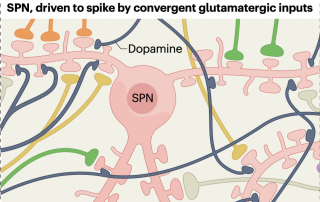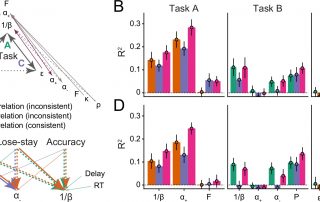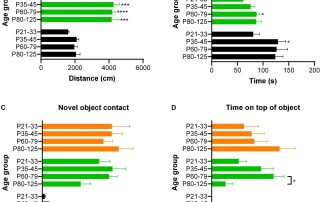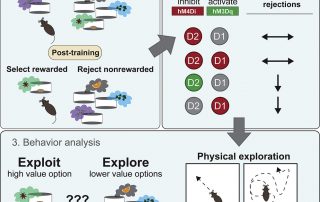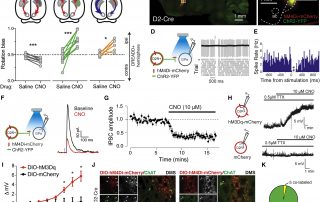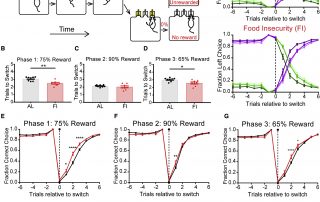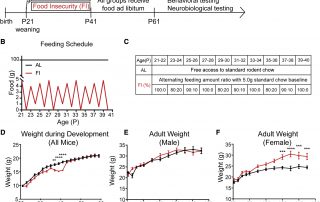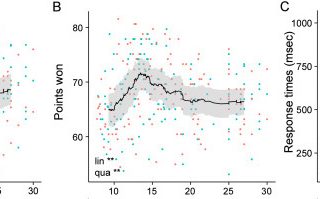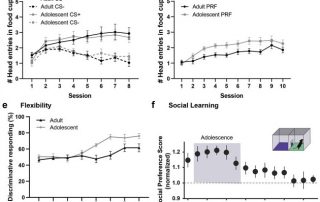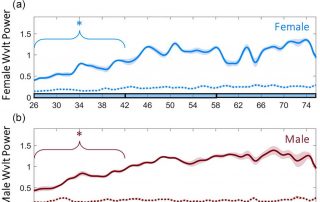
Pubmed: Wilbrecht L
Hidden state inference requires abstract contextual representations in ventral hippocampus
The ability to form and utilize subjective, latent contextual representations to influence decision making is a crucial determinant of everyday life. The hippocampus is widely hypothesized to bind together otherwise abstract combinations of stimuli to represent such latent contexts, and to allow their use to support the process of hidden state inference. Yet, direct evidence for this remains limited. Here we show that the CA1 area of the ventral hippocampus is necessary for mice to perform hidden state inference during a 2-armed bandit task. vCA1 neurons robustly differentiate between the two abstract contexts required for this strategy in a manner similar […]
Adolescent and adult mice use both incremental reinforcement learning and short term memory when learning concurrent stimulus-action associations
Computational modeling has revealed that human research participants use both rapid working memory (WM) and incremental reinforcement learning (RL) (RL+WM) to solve a simple instrumental learning task, relying on WM when the number of stimuli is small and supplementing with RL when the number of stimuli exceeds WM capacity. Inspired by this work, we examined which learning systems and strategies are used by adolescent and adult mice when they first acquire a conditional associative learning task. In a version of the human RL+WM task translated for rodents, mice were required to associate odor stimuli (from a set of 2 or 4 […]
Goal-directed learning in adolescence: neurocognitive development and contextual influences
Adolescence is a time during which we transition to independence, explore new activities and begin pursuit of major life goals. Goal-directed learning, in which we learn to perform actions that enable us to obtain desired outcomes, is central to many of these processes. Currently, our understanding of goal-directed learning in adolescence is itself in a state of transition, with the scientific community grappling with inconsistent results. When we examine metrics of goal-directed learning through the second decade of life, we find that many studies agree there are steady gains in performance in the teenage years, but others report that adolescent goal-directed […]
The interpretation of computational model parameters depends on the context
Reinforcement Learning (RL) models have revolutionized the cognitive and brain sciences, promising to explain behavior from simple conditioning to complex problem solving, to shed light on developmental and individual differences, and to anchor cognitive processes in specific brain mechanisms. However, the RL literature increasingly reveals contradictory results, which might cast doubt on these claims. We hypothesized that many contradictions arise from two commonly-held assumptions about computational model parameters that are actually often invalid: That parameters generalize between contexts (e.g. tasks, models) and that they capture interpretable (i.e. unique, distinctive) neurocognitive processes. To test this, we asked 291 participants aged 8–30 years […]
The maturation of exploratory behavior in adolescent Mus spicilegus on two photoperiods
Dispersal from the natal site or familial group is a core milestone of adolescent development in many species. A wild species of mouse, Mus spicilegus, presents an exciting model in which to study adolescent development and dispersal because it shows different life history trajectory depending on season of birth. M. spicilegus born in spring and summer on long days (LD) disperse in the first 3 months of life, while M. spicilegus born on shorter autumnal days (SD) delay dispersal through the wintertime. We were interested in using these mice in a laboratory context to compare age-matched mice with differential motivation to disperse. To first test if […]
Activation, but not inhibition, of the indirect pathway disrupts choice rejection in a freely moving, multiple-choice foraging task
The dorsomedial striatum (DMS) plays a key role in action selection, but less is known about how direct and indirect pathway spiny projection neurons (dSPNs and iSPNs, respectively) contribute to choice rejection in freely moving animals. Here, we use pathway-specific chemogenetic manipulation during a serial choice foraging task to test the role of dSPNs and iSPNs in learned choice rejection. We find that chemogenetic activation, but not inhibition, of iSPNs disrupts rejection of nonrewarded choices, contrary to predictions of a simple “select/suppress” heuristic. Our findings suggest that iSPNs’ role in stopping and freezing does not extend in a simple fashion to […]
Transient food insecurity during the juvenile-adolescent period affects adult weight, cognitive flexibility, and dopamine neurobiology
A major challenge for neuroscience, public health, and evolutionary biology is to understand the effects of scarcity and uncertainty on the developing brain. Currently, a significant fraction of children and adolescents worldwide experience insecure access to food. The goal of our work was to test in mice whether the transient experience of insecure versus secure access to food during the juvenile-adolescent period produced lasting differences in learning, decision-making, and the dopamine system in adulthood. We manipulated feeding schedules in mice from postnatal day (P)21 to P40 as food insecure or ad libitum and found that when tested in adulthood (after P60), […]
Reinforcement learning and Bayesian inference provide complementary models for the unique advantage of adolescents in stochastic reversal
During adolescence, youth venture out, explore the wider world, and are challenged to learn how to navigate novel and uncertain environments. We investigated how performance changes across adolescent development in a stochastic, volatile reversal-learning task that uniquely taxes the balance of persistence and flexibility. In a sample of 291 participants aged 8–30, we found that in the mid-teen years, adolescents outperformed both younger and older participants. We developed two independent cognitive models, based on Reinforcement learning (RL) and Bayesian inference (BI). The RL parameter for learning from negative outcomes and the BI parameters specifying participants’ mental models were closest to optimal […]
Making sense of strengths and weaknesses observed in adolescent laboratory rodents
During adolescence, rodents disperse from their natal site, find a new home, and navigate social relationships and threats. Although rats and mice in the laboratory cannot fully express these natural behaviors, they show striking changes in their affective and cognitive behavior across the adolescent period. In some laboratory-based behavior metrics, adolescent rodents fail to show the same behaviors expressed by adults, but in other metrics, adolescent behavioral performance is more robust or more flexible than at other ages. These data are often interpreted in light of proximate level analysis of development of neural circuits. It is also informative to attempt ultimate-level […]
Sex Differences in Pubertal Circadian and Ultradian Rhythmic Development Under Semi-Naturalistic Conditions
Biological rhythms in core body temperature (CBT) provide informative markers of adolescent development under controlled laboratory conditions. However, it is unknown whether these markers are preserved under more variable, semi-naturalistic conditions, and whether CBT may therefore prove useful in a real-world setting. To evaluate this possibility, we examined fecal steroid concentrations and CBT rhythms from pre-adolescence (p26) through early adulthood (p76) in intact male and female Wistar rats under natural light and climate at the Stephen Glickman Field Station for the Study of Behavior, Ecology and Reproduction. Despite greater environmental variability, CBT markers of pubertal onset and its rhythmic progression were […]


